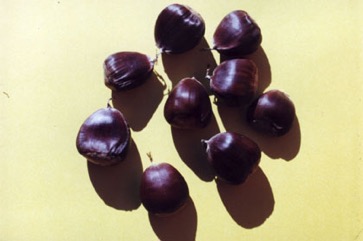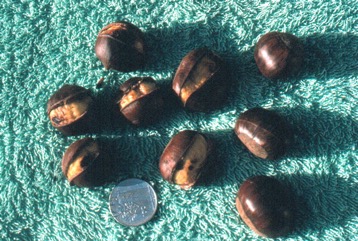European Chestnut, Sweet chestnut, Spanish chestnut

A Mediterranean climate plant. It can withstand frost. Trees do produce in the highlands of South India so may produce in the highlands of PNG. It requires light to medium, well drained soils. It is drought tender. It is slightly hardier than a peach and has less chilling requirement than a walnut. It is not suited to heat or humidity. In Indonesia it is planted above 1,400 m above sea level. It suits hardiness zones 5-9. Arboretum Tasmania. Hobart Botanical Gardens.
Also known as:
Castagno, Castana, Castano, Chataignier, Edelkastanie, Gastana, Geszkenye, Geskonye, Italian chestnut, Kapoo, Khanor, Mitha, Pravi kostanj, Szelidgesztenye, Thit-e, Tzabli, Yadliv kesten
Synonyms
- Castanea vesca Gaertn.
- Castanea vulgaris Lam.
- Castanea castanea Karst.
- Fagus castanea L.
- Fagus procera Salisb., nom. illeg.
Edible Portion
- Nuts, Seeds, Flavouring
Where does European Chestnut grow?
Found in: Africa, Albania, Algeria, Armenia, Australia, Austria, Azerbaijan, Balkans, Bosnia, Brazil, Britain, Bulgaria, Caucasus, Chile, China, Cuba, East Africa, Europe, Falklands, France, Georgia, Greece, Haiti, Himalayas, Hungary, India, Indonesia, Iran, Italy, Jamaica, Japan, Macedonia, Mediterranean, Madagascar, Mexico, Morocco, Myanmar, North Africa, North America, Pacific, Pakistan, Papua New Guinea, PNG, Russia, San Marino, SE Asia, Serbia, Slovenia, South America, Spain, Tasmania, Tunisia, Turkey, United States, West Indies, Yugoslavia
Notes: All Castanea bear edible nuts. There are about 12 Castanea species.
Status: Seeds have been introduced into Papua New Guinea for growing trials only
Growing European Chestnut, Sweet chestnut, Spanish chestnut
Cultivation: Trees are mostly grown from seeds, but it is better to use grafted trees onto chestnut seedlings. Trees can be grown from cuttings. They can also be grown by layering. Seeds should be from cross pollinated trees and should be stored in a refrigerator at just below freezing for several months to break the dormancy, before planting. Some trees need to be cross pollinated, but some kinds will self between male and female flowers on the one tree. Pollination is by wind so trees should be near each other. Normally trees are trained to have a single trunk with at least 1.5 m to the lowest branch.
Edible Uses: The kernel of the nuts is eaten boiled or roasted. They are also slowly dried then ground and made into porridge. The flour can be used for breads, puddings or used to thicken soups. The roasted seeds are used as a coffee substitute. Sugar can be extracted from the nuts.
Production: This is the fastest growing of the chestnuts. Trees can live for centuries. Seedling trees can bear after 3-10 years. Up to 100 kg of nuts can be produced per year. There is little seasonal fluctuation in nut production. The nuts fall naturally. The nuts need to be partly dried to improve the taste and stop rots. The nuts can be stored in closed boxes, with newspaper to absorb the moisture. If kept cool they will store for 6 months. Kernels can be kept for much longer if cooked and frozen. To do this the nut is placed in boiling water for 2 minutes then peeled and cooled and frozen.
Nutrition Info
per 100g edible portion| Edible Part | Energy (kcal) | Protein (g) | Iron (mg) | Vitamin A (ug) | Vitamin c (mg) | Zinc (mg) | % Water |
|---|---|---|---|---|---|---|---|
| Nuts | 172 | 2 | 0.9 | 0 | 27 | - | 51.7 |
European Chestnut, Sweet chestnut, Spanish chestnut Photos


References
Ambasta S.P. (Ed.), 2000, The Useful Plants of India. CSIR India. p 110
Bianchini, F., Corbetta, F., and Pistoia, M., 1975, Fruits of the Earth. Cassell. p 190
Blamey, M and Grey-Wilson, C., 2005, Wild flowers of the Mediterranean. A & C Black London. p 31
Bodkin, F., 1991, Encyclopedia Botanica. Cornstalk publishing, p 224
Bonet, M. A. & Valles, J., 2002, Use of non-crop food vascular plants in Montseny biosphere reserve (Catalonia, Iberian Peninsula). International Journal of Food Sciences and Nutrition (2002) 53, 225–248
Bremness, L., 1994, Herbs. Collins Eyewitness Handbooks. Harper Collins. p 43
Brickell, C. (Ed.), 1999, The Royal Horticultural Society A-Z Encyclopedia of Garden Plants. Convent Garden Books. p 235
Brouk, B., 1975, Plants Consumed by Man. Academic Press, London. p 212
Brown, D., 2002, The Royal Horticultural Society encyclopedia of Herbs and their uses. DK Books. p 158
Bussman, R. W., et al, 2016, A comparative ethnobotany of Khevsureti, Samtskhe-Javakheti, Tusheti, Svaneti, and Racha-Lechkhumi, Republic of Georgia (Sakartvelo), Caucasus. Journal of Ethnobiology and Ethnomedicine (2016) 12:4
Cerne, M., 1992, Wild Plants from Slovenia used as Vegetables. Acta Horticulturae 318.
Cheifetz, A., (ed), 1999, 500 popular vegetables, herbs, fruits and nuts for Australian Gardeners. Random House p 176
Coombes, A.J., 2000, Trees. Dorling Kindersley Handbooks. p 150
Cundall, P., (ed.), 2004, Gardening Australia: flora: the gardener's bible. ABC Books. p 339
Daly, A. B., 20014, Narrating changing foodways: wild edible plant knowledge and traditional food systems in Mapuche lands of the Andean Temperate Forests, Chile. Masters Thesis Vancouver. p 45
Denes, A., et al, 2012, Wild plants used for food by Hungarian ethnic groups living in the Carpathian Basin. Acta Societatis Botanicorum Poloniae 81 (4): 381-396
Dogan, Y. et al, 2013, Wild Edible Plants sold in the Local Markets of Izmir, Turkey. Pak. J. Bot. 45(S1): 177-184
Ertug, F, Yenen Bitkiler. Resimli Türkiye Florası -I- Flora of Turkey - Ethnobotany supplement
Etherington, K., & Imwold, D., (Eds), 2001, Botanica's Trees & Shrubs. The illustrated A-Z of over 8500 trees and shrubs. Random House, Australia. p 188
Facciola, S., 1998, Cornucopia 2: a Source Book of Edible Plants. Kampong Publications, p 114
FAO, 1995, Edible Nuts. Non Wood Forest Products 5.
Flowerdew, B., 2000, Complete Fruit Book. Kyle Cathie Ltd., London. p 200
French, B.R., 1986, Food Plants of Papua New Guinea, A Compendium. Asia Pacific Science Foundation p 184
Gard. dict. ed. 8: Castanea no. 1. 1768
Glowinski, L., 1999, The Complete Book of Fruit Growing in Australia. Lothian. p 121
Gonzalez, J. A., et al, 2011, The consumption of wild and semi-domesticated edible plants in the Arribes del Duero (Salamanca-Zamora, Spain): an analysis of traditional knowledge. Genetic. Resour Crop Evolution 58:991-1006
Gouldstone, S., 1983, Growing your own Food-bearing Plants in Australia. Macmillan p 139
Harris, E & J., 1983, Field Guide to the Trees and Shrubs of Britain. Reader's Digest. p 110
Hedrick, U.P., 1919, (Ed.), Sturtevant's edible plants of the world. p 175
Heywood, V.H., Brummitt, R.K., Culham, A., and Seberg, O. 2007, Flowering Plant Families of the World. Royal Botanical Gardens, Kew. p 148
Irving, M., 2009, The Forager Handbook, A Guide to the Edible Plants of Britain. Ebury Press p 54
Janaćković, P. et al, 2019, Traditional knowledge on plant use from Negotin Krajina (Eastern Serbia): An ethnobotanical study. Indian Journal of Traditional Knowledge Vol 18 (1), pp 25-33
Jardin, C., 1970, List of Foods Used In Africa, FAO Nutrition Information Document Series No 2.p 12
Lazarides, M. & Hince, B., 1993, Handbook of Economic Plants of Australia, CSIRO. p 51
Lord, E.E., & Willis, J.H., 1999, Shrubs and Trees for Australian gardens. Lothian. p 49
Lorenzi, H., Bacher, L., Lacerda, M. & Sartori, S., 2006, Brazilian Fruits & Cultivated Exotics. Sao Paulo, Instituto Plantarum de Estuados da Flora Ltda. p 412
Lyle, S., 2006, Discovering fruit and nuts. Land Links. p 115
Mabey, R., 1973, Food for Free. A Guide to the edible wild plants of Britain, Collins. p 31
Macmillan, H.F. (Revised Barlow, H.S., et al) 1991, Tropical Planting and Gardening. Sixth edition. Malayan Nature Society. Kuala Lumpur. p 313
Menendez-Baceta, G., et al, 2012, Wild edible plants traditionally gathered in Gorbeialdea (Biscay, Basque Country) Genetic Reources and Crop Evolution 59:1329-1347
Menninger, E.A., 1977, Edible Nuts of the World. Horticultural Books. Florida p 14
Michael, P., 2007, Edible Wild Plants and Herbs. Grub Street. London. p 52
Miguel, E., et al, 1989, A checklist of the cultivated plants of Cuba. Kulturpflanze 37. 1989, 211-357
Mulherin, J., 1994, Spices and natural flavourings. Tiger Books, London. p 109
Nassif, F., & Tanji, A., 2013, Gathered food plants in Morocco: The long forgotten species in Ethnobotanical Research. Life Science Leaflets 3:17-54
Nebel, S., Pieroni, A. & Heinrich, M., 2006, Ta cho`rta: Wild edible greens used in the Graecanic area in Calabria, Southern Italy. Appetite 47 (2006) 333–342
Nedelcheva A., 2013, An ethnobotanical study of wild edible plants in Bulgaria. EurAsian Journal of BioSciences 7, 77-94
Negi, P. S. & Subramani, S. P., 2015, Wild Edible Plant Genetic Resources for Sustainable Food Security and Livelihood of Kinnaur District, Himachal Pradesh, India, International Journal of Conservation Science. 6 (4): 657-668
Pardo-de-Santayana, M., et al, 2005, The gathering and consumption of wild edible plants in the Campoo (Cantabria, Spain). International Journal of Food Sciences and Nutrition. 56(7): 529-542
Pieroni, A., 1999, Gathered wild food plants in the Upper Valley of the Serchio River (Garfagnana), Central Italy. Economic Botany 53(3) pp 327-341
Pieroni, A., et al, 2005, Food for two seasons: Culinary uses of non-cultivated local vegetables and mushrooms in a south Italian village. International Journal of Food Sciences and Nutrition, 56(4): 245-272
Plants for a Future database, The Field, Penpol, Lostwithiel, Cornwall, PL22 0NG, UK. http://www.scs.leeds.ac.uk/pfaf/
Plants of Haiti Smithsonian Institute http://botany.si.edu/antilles/West Indies
PROSEA (Plant Resources of South East Asia) handbook, Volume 2, 1991, Edible fruits and nuts.
Redzic, S. J., 2006, Wild Edible Plants and their Traditional Use in the Human Nutrition in Bosnia-Herzegovina. Ecology of Food and Nutrition, 45:189-232
Rigat, M et al, 2009, Ethnobotany of Food Plants in the High River Ter Valley (Pyrenees, catalonia, Iberian Peninsula): Non-Crop Food Vascular Plants and Crop Food Plants with medicinal Properties. Ecology of Food and Nutrition, 48:303-327
Sansanelli, S., et al, 2014, Wild food plants traditionall consumed in the area of Bologna (Emilia Romagna region, Italy). Journal of Ethnobiology and Ethnomedicine 10:69
Schuler, S., (Ed.), 1977, Simon & Schuster's Guide to Trees. Simon & Schuster. No. 189
Schunko, C., et al, 2010, Organic farmers use of wild food plants and fungi in a hilly area in Styria (Austria). Journal of Ethnobiology and Ethnomedicine 6:17
Segura, S., et al, 2018, The edible fruit species in Mexico. Genet Resour Crop Evol (2018) 65:1767–1793
Sfikas, G., 1984, Trees and shrubs of Greece. Efstathiadis Group. Athens. p 154
Tardio, J., et al, 2006, Ethnobotanical review of wild edible plants in Spain. Botanical J. Linnean Soc. 152, 27-71
Upson, R., & Lewis R., 2014, Updated Vascular Plant Checklist and Atlas for the Falkland Islands. Falklands Conservation and Kew.
USDA, ARS, National Genetic Resources Program. Germplasm Resources Information Network - (GRIN). [Online Database] National Germplasm Resources Laboratory, Beltsville, Maryland. Available: www.ars-grin.gov/cgi-bin/npgs/html/econ.pl (10 April 2000)
van Wyk, B., 2005, Food Plants of the World. An illustrated guide. Timber press. p 125
Verheij, E. W. M. and Coronel, R.E., (Eds.), 1991, Plant Resources of South-East Asia. PROSEA No 2. Edible fruits and nuts. Pudoc Wageningen. p 324
Wickens, G.E., 1995, Edible Nuts. FAO Non-wood forest products. FAO, Rome. p 21, 124
World Checklist of Useful Plant Species 2020. Royal Botanic Gardens, Kew
www.chileflora.com
Young, J., (Ed.), 2001, Botanica's Pocket Trees and Shrubs. Random House. p 206